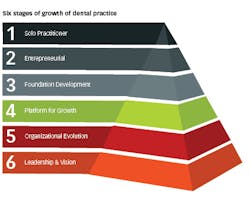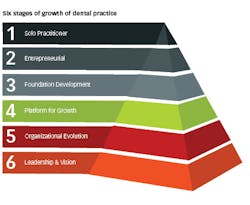6 stages of growth: From solo practice to dental service organization
Editor's note: This article is part one of a seven-part series.
Look at just about any report on the status of the dental industry today, and you’ll see that private equity–backed multisite dental groups (known as dental service organizations, or DSOs) are growing across the board. As their growth continues, these businesses are poised to become an increasingly influential part of the dental marketplace. In particular, group practices having between two and 20 locations (emerging group practices) are experiencing considerable growth.
If you’re considering building a multisite dental group, you need to have a sense of what lies ahead before you begin building new offices or acquiring existing ones. Growing a practice from a single office to multiple locations is not easy, but it can be done logically and in progressive steps that build on one another so you can develop a solid foundation for future growth.
It took 20 years of growing dental practices as an entrepreneur for me to realize that as diverse as dental practices can be, they each progress through the same six stages of growth. Here is a brief overview of each stage, which I will discuss individually in six subsequent articles.
Stage 1: Solo practitioner (one office)
This is the stage where you define yourself: you choose your niche, establish where you want to practice, create your brand identity, and develop your practice’s culture—mission, purpose, and values. You can stay here with one office or take the next steps toward entrepreneurial growth.
Stage 2: Entrepreneurial (two to three offices)
One of the more challenging of the six stages, this is where you build significant parts of the foundation on which all future practices will be built, including officewide systems and policies and procedures. You put clinical mentoring in place and identify and track essential metrics. You are the biggest producer for the practice and, you must run between offices in order for each to be profitable.You take on various duties, including launching marketing campaigns and paying your own bills, but you struggle to be a good manager, and you fall into the trap of micromanaging. However, you figure out ways to foster a strong culture, and you encourage your team with regular team meetings and an incentive plan.
Stage 3: Foundation development (four to nine offices)
With a few practices under your belt, you start to define your business model, in particular—whether you’ll centralize or decentralize certain functions of the business, and whether you’ll deploy an acquisition or de novo strategy. In addition, you choose between a branded or nonbranded model. There is no right path, but you need to understand the pros and cons of each because it will affect how you build your team and where you focus your resources. You begin to run your business off of clinical and financial metrics rather than your bank account balance and instincts. You evaluate how to leverage your resources by using outsourced vendors. You become better at hiring the right people and putting them in the best roles possible. You develop a mentoring program for your dentists and take the crucial step of investing in your training program to ensure that your team provides consistent care and customer service for your patients in all offices. You learn how to become a better leader and how to delegate, and you’ve likely realized that your practices run fine when you don’t visit each one every day. In fact, they may work better.
Stage 4: Platform for growth (10 to 20 offices)
With more offices coming on board, you will need a designated team to integrate acquired offices or to launch de novo offices. If bringing on partners is a part of your platform for growth, you may want to establish a “path to partnership.” In this stage, financing for growth often becomes more difficult. You further define your role in the company. Are you a chief executive officer (CEO) or chief dental/clinical officer (CDO)? Once you decide, you need to actively search and hire for the other position.
Stage 5: Organizational evolution (21 to 40 offices)
You evolve your clinical and operational systems and continue to build your practice support team. This includes increasing your focus on your business development team and investing in the highest level of leadership, including a CEO, chief operations officer (COO), chief financial officer (CFO), and CDO. You may receive third-party investment or you may have negotiated with your lending institution to increase your borrowing capacity, and you may even be able to remove personal liability.
Spotlight: metrics*
Whatever stage you’re in, it’s critical that you have easy access to your data so you can measure your progress and recognize potential areas for improvement. This requires having practice management software that allows you to pull key data to determine what’s working, what isn’t, and what you need to change to get stronger. Practices in Stages 1 and 2 have a variety of options for practice management software because their data isn’t distributed across many locations. But as your organization expands, keep in mind that you’ll need better capabilities to centralize your data. As you feel the growing pains, it’s time to move up to a strong enterprise software that can support multiple locations and allow you to manage data across your offices.
*Spotlight sponsored by Henry Schein’s Dentrix Enterprise.
Stage 6: Leadership and vision (40+ offices)
In the final stage, you continue to build out your executive team by hiring, for example, a chief marketing officer (CMO). You also bring most third-party outsourced services in-house, such as IT, legal, compliance, and other services that make the most economic sense for your business model. To date, you may have operated in one geographic region, but now you are evaluating or have expanded into markets in new states, and you focus on developing techniques to maintain consistent communication and culture across states. If you didn’t receive third-party financing in Stage 5, you may need it now, depending on the speed of your growth. Atthis point, the addition of a new office will barely impact your day-to-day operations. From this point on, it’s a matter of repeating your proven systems. By Stage 6, the primary limit is your vision for growth.
By understanding what lies ahead, you can spot opportunities, avoid pitfalls, and maintain your sanity, which often feels like the first thing to go when you start growing beyond a solo practice. You’ll make mistakes along the way, of course, perhaps growing a department too fast or missing a training opportunity. But if you have patience, stay committed, and learn from the trials and errors of those who walked before you, you’re far more likely to succeed.
Welcome to the path of building your own multisite dental group. See you next month as we dive into Stage 1.
Vincent Cardillo, MBA, has more than 20 years of experience owning, leading, and partnering with DSOs, the latest of which was No. 14 on the 2014 Inc. 500 List. He is the founder of Dental Management Innovations LLC. DMI positions clients for growth by strengthening their operational systems and infrastructure. Mr. Cardillo also provides his expertise to private equity firms and institutional investors. His book on the six stages of growth will be published later this year. Contact him at [email protected].

